Activities to Restore the Tropical Rainforests and Conserve Borneo's Ecosystem


1. Outline
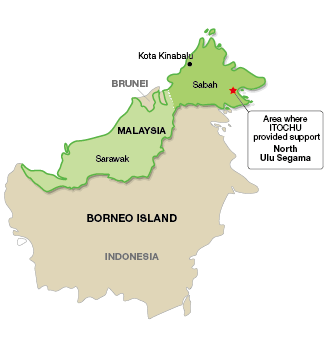
A worldwide issue, the striking decline and deterioration of tropical rainforests and the accompanying collapse of ecosystems even today has not stopped. In addition, it is also said that the destruction of forests is a source of the increase in CO2 that is a cause of global warming.
The island of Borneo (Kalimantan) is a tropical rainforest region extending across the three nations of Malaysia, Indonesia and Brunei. With a surface area that is approximately 1.9 times that of Japan, it is the third largest island in the world.
Ranked with the Amazon, the island of Borneo is considered a treasure house of biodiversity, but recently development has made headway and some of the Bornean tropical rainforests have been damaged to the degree that it is not possible to maintain the ecosystem with natural regenerative power alone. This program is designed to assist with the regeneration of these damaged rainforests. In the northeast of Borneo, at North Ulu Segama in the state of Sabah in Malaysia, WWF (World Wide Fund for Nature), an international conservation organization, is collaborating with the Sabah Forestry Department (SFD), to carry out reforestation of an area of approximately 2,400 hectares. Within the area, the ITOCHU Group supported the forest restoration program to restore 967 hectares of degraded forest. This is the largest area of responsibility for the restoration project undertaken by any private company. The land in question is also a habitat for Bornean Orangutans, an endangered species. The reforestation not only protects the Bornean Orangutans; it is linked to the protection of many living creatures whose habitat is here.
Planting and on-site maintenance work of all 967 hectares, which were started in 2009, were completed on January 14, 2016.
On February 19, 2016, a session for reporting the completion of the program was held by personnel from WWF Japan and WWF Malaysia.
CEO Ryuji Tsutsui of WWF Japan offered a letter of appreciation to the ITOCHU Group for its outstanding contribution to the conservation of the tropical rainforests of Borneo, which is one of the most valuable forest ecosystems in the world, through the support provided under this program over a period of roughly seven years.
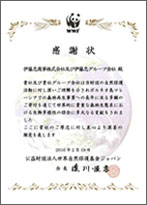
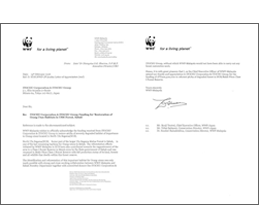
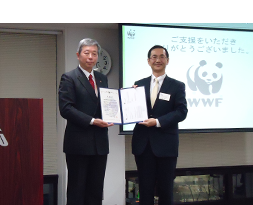
Please visit the official website of WWF Japan for a report on this program.
2. Program Description
(1)Outline
| Recipient |
WWF Japan |
| Term |
From FY2009 to FY2015 |
| Location |
Borneo (North Ulu Segama, Sabah, Malaysia) |
| Area |
967 hectares (contract area/ slightly larger than a 3 km × 3 km square area) |
| Contribution |
A total of 250 million yen (including donations from Group companies) |
| Tree-planting |
Tree species such as Dipterocarpaceae species that were appropriate to local conditions were planted. Planted trees were undertook maintenance for a period of approximately 7 years. Please refer to 2 (5) |
| Employee volunteering |
ITOCHU Group employee volunteers have been involved in local reforestation activities (tree-planting, cutting undergrowth), wildlife observation, and other activities, including those from Group companies. |
(2) Description of the activities
Reforestation was carried out jointly by WWF Japan and WWF Malaysia. Seedlings of tree species which are native to the island of Borneo were planted at a regular interval and on-site maintenance work, including weeding around each seedling, was continued for approximately two years after the planting, aiming to restore the forests. These tasks were performed by following methods that were agreed by SFD and WWF Malaysia. The tasks were performed meticulously. For example, as many as around 60 species of trees were planted in conformity to the environment. In addition, WWF and SFD conducted on-site checks of each task to ensure that it was being performed in accordance with the standard, and corrective tasks were conducted where the standards were not followed.
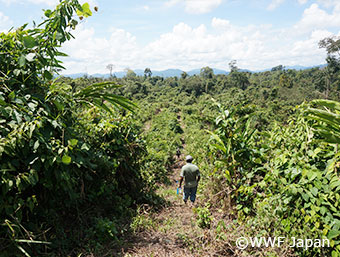
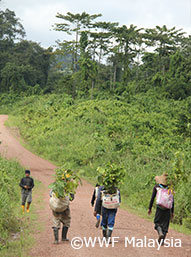
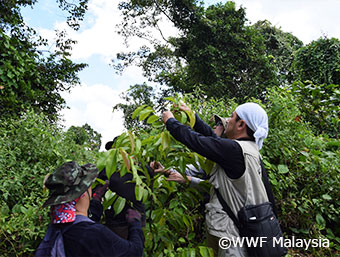
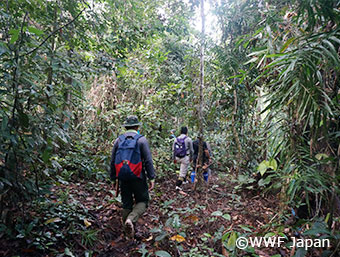
(3) Voluntary tree-planting activities by ITOCHU Group employees
In addition to providing financial support for this program, ITOCHU conducted employee volunteer tours, which permitted ITOCHU Group employees from around the world to participate in the tree-planting activities, etc. under the program, as part of the environmental education of its employees.
The experiences the ITOCHU Group employees had on the tours were summarized in the volumes of the News from Borneo.
(4) Achievements of the program
WWF conducted scientific research to measure the impacts of the North Ulu Segama Reforestation Project (reforestation activities in approximately 2,400 hectares of area for which WWF was responsible, including 967 hectares supported by the ITOCHU Group). The research has revealed a positive change; that is, forest cover has been increased in the restored areas. In addition, a study of Bornean Orangutans, which were seen only in the remaining few areas of forest in relatively good condition before the launch of the project, has revealed that they are beginning to be active across a wider range. This means that the part of the forest that had been degraded by fires and deforestation to the extent that it was unusable for Bornean Orangutans has gradually recovered thanks to the reforestation activities. In fact, Bornean Orangutans began to be directly observed in 2012 using trees that had been planted in the reforestation activities and since grown.
Area around the ITOCHU Group’s signboard
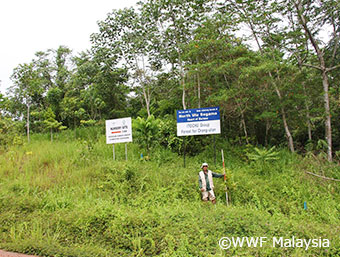
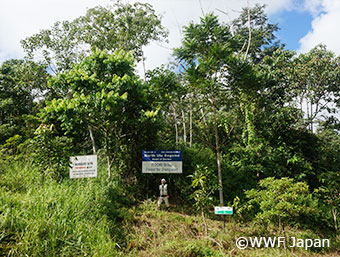
The photos show that the trees that had been planted in 2012 had already grown significantly in 2016.
Changes of forest cover from 2008 to 2013
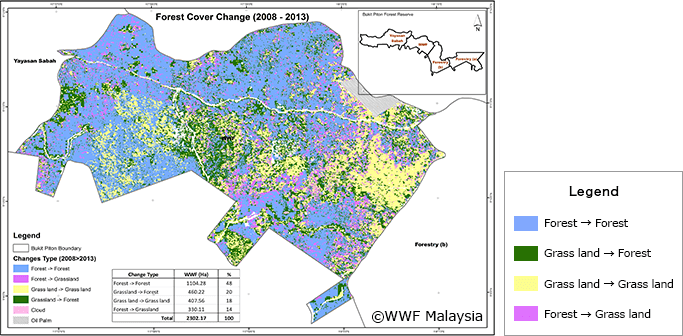
The green parts are areas that were grassland or shrubs without trees in 2008 but had been restored and became a forest status in 2013. These parts account for approximately 20% of the 2,400 hectares of land for which WWF was committed to carry out a forest restoration work. Of approximately 860 hectares of land that was previously grassland in 2008, approximately 460 hectares were changed into forest status.
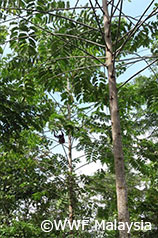
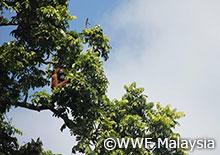
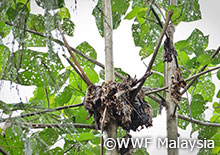
In addition, the entire Ulu Segama Malua Forest Management Unit, including North Ulu Segama, was certified as a well-managed forest in 2011 by the Forest Stewardship Council (FSC). In 2012, the Sabah Forestry Department (SFD) recognized the importance of North Ulu Segama and decided to reclassify North Ulu Segama as a Class I Forest Reserve, where commercial logging is prohibited. At the same time, North Ulu Segama, which had previously been part of the Ulu Segama Forest Reserve, was renamed “Bukit Piton Class I Forest Reserve” and became a new independent forest reserve.
Please visit the official website of WWF Japan for more additional details and outcomes of the reforestation activities.
(5) Data: Examples of tree species that were planted
Tree species which grow quickly (pioneer species), those which grow slowly (Dipterocarpaceae plant are the majority), and those that bear fruit as food for Bornean Orangutans were planted at a constant rate.
